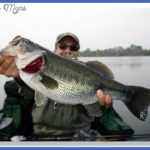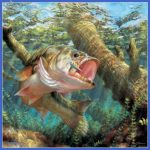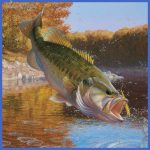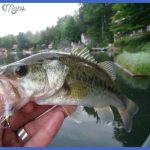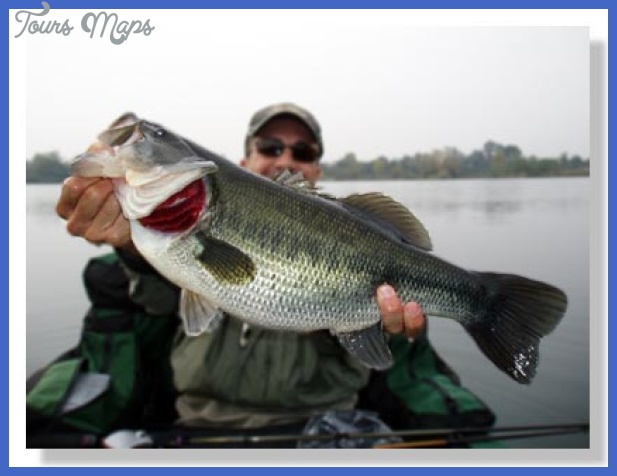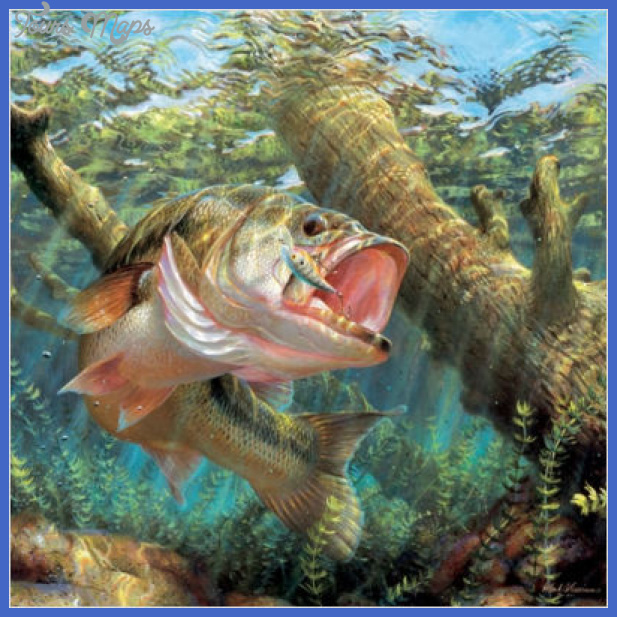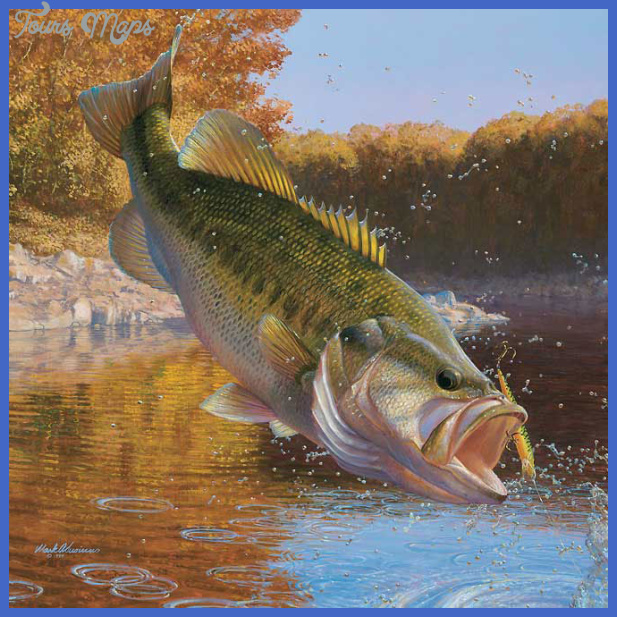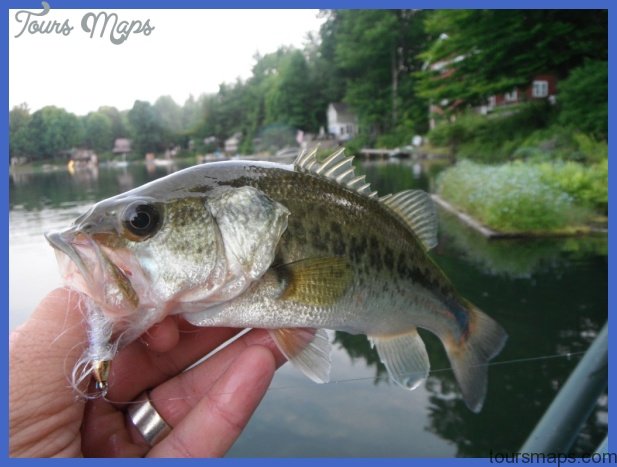Largemouth bass, Micropterus salmoides, represent a new and growing sport fishery in Maine. Until recently, Maine anglers considered largemouths to be “trash fish.” Now, many anglers are aware that largemouths can provide fast-paced, exciting sport. Maine’s record largemouth bass weighed 11.63 pounds.
Maine largemouths do not grow as large as those found in the extreme southern states, simply because they have a shorter season in which to grow. As far as providing sport, the sheer numbers of largemouth bass in Maine make up for the slightly smaller average size. And nobody scoffs at the 4- to 6-pound fish so common in Maine.
Largemouth bass are voracious feeders, especially in the spring and early summer. Even when ice covers Maine lakes and ponds, largemouths cannot take a hiatus from feeding; they need the calories provided by bait fish in order to survive. Maine largemouth bass are lethargic during periods of extreme hot weather, but in the Pine Tree State such uncomfortable conditions soon pass. Even during heat spells, the diligent angler can entice Maine’s largemouth bass to respond. Early morning and evening hours are best during the dog days.
Many lakes and ponds in southern and central Maine either lack sufficient dissolved oxygen or are not cold enough to host viable populations of coldwater game fish, so largemouth bass have been introduced in order to supplement the trout and salmon fisheries. Small ponds in particular have been targeted for largemouth bass. An angler could spend many years and not cover all of Maine’s largemouth bass waters.
Maine largemouths begin to bite immediately after ice-out, but few anglers try for them then. You can have a prime southern Maine bass lake all to your- self if you go in late April. The fish will be in rather shallow water at this time.
Concentrate on the mouths of small streams and brooks; the water there will be warmer, which is attractive to largemouth bass.
Generally, Maine bass are on their spawning beds in June. By July, the fish take to deep water during the day, returning to the shallows in the evening to feed.
Many Maine bass ponds and lakes are bounded by wetlands and boggy areas. These shorelines provide perfect largemouth bass habitat. Often, wave action will undercut the banks, providing cover for largemouths. All the bass has to do is wait for a bait fish or other prey to swim by, then dash out and grab it. A good number of Maine’s slow-moving rivers provide similar habitat, although these areas are usually overlooked by the largemouth fraternity.
In these boggy areas, fish will continue to filter into the feeding spots on the edges of bogs and wetlands. If you take a fish in a certain spot today, you can bet that another one will soon station itself in the same spot.
Techniques
Spin fishing – Probably more Maine anglers use spinning tackle than fly tackle when fishing for largemouth bass. A medium-weight outfit with at least 8-pound test line is all you need. If you are hunting for a trophy, or are fishing waters that contain pike as well as bass, you might want a medium to heavy outfit with 12-pound test.
Maine bass are no different from bass in any other state. All the standard bass lures are productive but plastic worms seem to be the most popular. These and similar plastic baits such as salamanders are extremely effective on Maine largemouths. Although some anglers use a number of worm-hooking methods, the author has found that leaving the hook exposed results in more fish hooked and a longer life for plastic bait. Maine largemouths are not hook-shy and will not drop the bait if they detect the hook.
The boggy shorelines mentioned earlier are perfect spots for casting a plastic worm. The only way to fish these places is from a boat or canoe. Some anglers like to anchor within casting distance from shore and cast toward the bogs. On calm days, it is possible to dispense with the anchor. You must drop your bait as close to the shore as possible in order to draw the fish out. If a fish takes it and runs out toward deep water, you can allow the fish to take the bait as long as you wish. If, on the other hand, it heads back under its boggy hiding place, you must strike as soon as possible.
Be aware that if you make a bad cast and your bait hangs up in the brush, you will put the fish down in that area if you decide to physically retrieve the lure. If that does happen, especially before you have covered the area fully, go to another spot and return to the area you disturbed in an hour or so. Largemouth bass have short memories and your previous intrusion will be long forgotten.
Boggy shorelines are also great spots for topwater action, especially before the lily pads have reached the surface. As with plastic baits, try to drop your lure as close to the shore as possible.
Fall fishing is a hit-or-miss proposition, but some of the biggest bass of the year can be taken in September. By then, the water is uniformly cool and crystal-clear. Look for bass around points, where they will feed on bait fish. Try fishing dropoffs and around structure. The fish should be in 5 to 20 feet of water at this time of year.
Trolling – Trolling is not a suggested method of fishing for largemouth bass. Largemouth bass are sometimes taken as an incidental catch by anglers using dodgers and streamer flies or metal lures while brown trout fishing.
Fly casting – Fly fishing is an exciting way to take Maine’s largemouth bass. Anglers using cork-bodied poppers or Henshall-style deer-hair flies can have topnotch sport. Mornings and evenings are the best for topwater action. You can fish from shore, by wading, or you can cast from a boat or canoe. Even in summer’s heat, bass will rise to topwater offerings in mornings, evenings, and at night.
Leech patterns are preferred by daytime anglers. These flies are simple to tie. Note that leeches are prevalent in many of the boggy areas where largemouth bass live, and the fish are used to feeding on them. The author’s favorite leech pattern consists of a size 2 hook with a black floss body. Four long, black saddle hackles are tied in at the head and two bead-chain eyes are attached at the top of the head. When cast and allowed to sink a few feet before imparting action, these flies are deadly. You might consider them the fly fisher’s version of the plastic worm.
Since most fly fishing is done near weed beds or structure, you need a rather stout leader. It needn’t be long6 to 8 feet is plentybut it should test at least 8 pounds. A floating fly line for topwater and a sinking line for leech patterns round out the bill. Reels needn’t be elaborate, since largemouths don’t make long runs. You should use at least a 6-weight outfit; for windy days, or when topwater fishing, an 8-weight outfit with a weight-forward line is recommended. Fly rods should be from 8 to 9 feet long.
Bait casting – Baitcasting tackle is not too popular in Maine, but it should be, since it is ideally suited for fishing Maine’s largemouth bass lakes. Modern bait casting reels allow the angler to make longer casts with lighter lures than did the reels of 25 years ago. Bait casters use the same lures as spin fishers and apply the same techniques. Bait casting tackle may be your best bet when fishing shallow, weedy ponds and lakes, since it is well suited for wrestling big fish in heavy cover. Standard bait casting tackle can easily coax a bass out and away from the rubbery stems of the lillies.
An angler working a boggy shoreline with bait casting tackle can cover the territory quicker than someone using spinning tackle. Bait casting tackle is also perfect for midsummer, when bass are found beneath floating lily pads.
Bait fishing – Maine anglers know live bait is deadly on lunker bass. Trophy hunters use the largest minnows available, up to 6 or 8 inches long. Heavy spinning or baitcasting tackle is preferred, and lines should be at least 12-pound test.
Bait fishermen rely on live minnows. The constant movement of the minnow draws bass from considerable distances. Use a bobber to keep the bait from getting wound around weeds and debris on the bottom.
Some anglers allow their boat or canoe to drift while dragging a lip-hooked minnow on the bottom. This is especially effective during Maine’s short summer, when bass are in water between 20 and 40 feet deep.
Any minnow is effective on bass, but most anglers prefer golden shiners. Night crawlers, hooked once through the collar, are a close second to minnows. Use night crawlers as you would a plastic worm. That is, do not add unnecessary weight, and cast the bait close to the shore or structure. When a largemouth bass takes a night crawler, you must strike quickly.
Ice fishing – Only a handful of Maine anglers fish for largemouth bass through the ice, and those who do use live minnows and tip-ups. A better and more fast-paced method is to use a small metal jig. Largemouth bass respond well to jigs, and taking a 3 or 4 pound bass on a light jig rod is a real thrill.
Best bets for Maine largemouth bass: Cobbosseecontee Lake, Site 10; Great Pond, Site 11; Sebago Lake, Site 6; and North Pond, Site 12.
Fishing: Largemouth Bass Photo Gallery
Maybe You Like Them Too
- The Best Cities To Visit in The World
- World’s 10 Best Places To Visit
- Coolest Countries in the World to Visit
- Travel to Santorini, Greece
- Map of Barbados – Holiday in Barbados

